Durability Assessment of Eco-Friendly Bricks Containing Lime Kiln Dust and Tire Rubber Waste Using Mercury Intrusion Porosimetry
Abstract
:1. Introduction
2. Materials Used in the Study
3. Experimental Program for Rubberized Brick Production
Production and Curing Procedure
- Vibration of the mix in three layers was carried out on a vibrating table. The first and second layers were vibrated for about 40 s each, and the final layer was vibrated for about 120 s. After the vibration was completed, the mix in the formwork was leveled to achieve a smooth and, leveled surface.
- After 48 h, the bricks were de-molded, sprayed with water, and wrapped with nylon film to enhance moist curing in an environment with an average humidity of 79% (±5%) and an average temperature of 19 °C (±5 °C), as shown in Figure 2.
- Hydration of the samples by spraying was carried out on alternate days until the curing ages of 7, 14, and 28 days. After each curing period, the brick samples were unwrapped as needed and tested.
4. Tests Carried Out on the Bricks
- Compressive strength (CS) test
- Ka = Aspect ratio factor determined by the height-to-thickness of the brick;
- P = Load that caused failure of the brick (kN);
- A = Area of the brick (mm2);
- CS = Computed compressive strength (MPa).
- Flexural strength (FS) test
- fcf = Flexural strength (MPa);
- P = Maximum applied force indicated by the testing machine (kN);
- L = Span length (mm);
- B = Average width of the specimen at the section of failure (mm);
- D = Average depth of specimen at the section of failure (mm).
- Freeze–thaw (F-T) test
- Mercury intrusion porosimetry (MIP) test
- Fc = Calculated frost resistance number/frost durability index;
- PV = Intruded pore volume (cm3/g or mL/g);
- P3 = Percentage of the pores with diameters greater than 3 µm.
- Water absorption test
- W = Water absorption (%);
- M1 = Weight of brick after oven-drying for 24 h (g);
- M2 = Weight of brick after soaking in water for 24 h (g).
5. Discussion of Results from the Tests
5.1. Compressive Strength (CS) and Flexural Strength (FS)
- fcf = Flexural strength;
- fc = Compressive strength.
5.2. Freeze–Thaw
- Physical appearance of the bricks before and after F-T
- Mass change of the bricks during the F-T test
5.3. Mercury Intrusion Porosimetry (MIP)
5.4. Water Absorption
6. Conclusions and Recommendations
- The brick samples produced with 0, 5, and 10% TRW had CS and FS results of 6.17, 5.25, and 3.09 MPa and 2.52, 2, and 1.55 MPa respectively. As standards require, these bricks passed the specifications for load- and non-load-bearing units for small buildings [49]. Additionally, the bricks produced with up to 10% TRW replacement passed the FS requirements for concrete bricks, which range between 1.4 and 3.4 MPa [69]. Thus, it can be concluded that the bricks produced with up to 10% TRW passed the CS and FS requirements for masonry units that can be used in small buildings.
- The power model developed in this study can be used to predict the flexural strength of the green bricks in the absence of a test. However, verification of the model considering different cementitious materials, types and sizes of aggregates, curing durations, and curing regimes can be performed.
- For the F-T tests, the brick samples produced with 0% TRW were seen to have no physical changes after 10 cycles of F-T. Hence, the samples produced with 0% TRW can be classed as frost-resistant bricks or frost-durable bricks, which can be used in environments where temperatures can be as low as −43 °C. The samples with 5 and 10% TRW had some physical changes on their surface in terms of delamination. Hence, the bricks produced with 5 and 10% TRW are not recommended for cold regions where temperatures can drop as low as −43 °C.
- The results of the MIP tests carried out on the brick samples containing 0, 5, and 10% TRW showed that two distinct pore sizes were present in the bricks. The bricks that had 0% TRW fell under the durable region, which was confirmed by their surface appearance after the F-T cycles. Furthermore, a peak intrusion volume of 0.095 mL/g was recorded for the 0% TRW (F-T), after which the curve flattened. This translates to durability, irrespective of the effect of the F-T cycles. The brick samples containing 5 and 10% TRW fell within the uncertain and non-durable regions, respectively, which can be attributed to the presence of the TRW in the bricks.
- WA tests performed on the samples showed that the bricks met the <20% standard requirements for WA. The WA values recorded for the bricks that contained 0, 5, and 10% TRW were 7.25, 11.76, and 14.96%, respectively.
Author Contributions
Funding
Institutional Review Board Statement
Informed Consent Statement
Data Availability Statement
Acknowledgments
Conflicts of Interest
References
- Maraveas, C. Production of Sustainable Construction Materials Using Agro-Wastes. Materials 2020, 13, 262. [Google Scholar] [CrossRef] [PubMed]
- Tempa, K.; Chettri, N.; Thapa, G.; Phurba Gyeltshen, C.; Norbu, D.; Gurung, D.; Wangchuk, U. An experimental study and sustainability assessment of plastic waste asa binding material for producing economical cement-less paver blocks. Engineering Science and Technology. Int. J. 2022, 26, 101008. [Google Scholar] [CrossRef]
- Oke, J.A.; Abuel-Naga, H.; Leong, E.-C. De-carbonizing in Construction using Supplementary Cementitious Materials and Accelerated Carbonation Technique—A Review. Int. J. Geotech. Eng. 2024, 1–22. [Google Scholar] [CrossRef]
- Pahroraji, M.E.H.M.; Saman, H.M.; Rahmat, M.N.; Kamaruddin, K.; Rashid, A.F.A. Compressive Strength and Density of Cementless Unfired Lightweight Brick Utilizing Coal Ash from Coal-Fired Thermal Power Plant. Key Eng. Mater. 2014, 594–595, 527–531. [Google Scholar] [CrossRef]
- Arulrajah, A.; Mohammadinia, A.; D’Amico, A.; Horpibulsuk, S. Effect of lime kiln dust as an alternative binder in the stabilization of construction and demolition materials. Constr. Build. Mater. 2017, 152, 999–1007. [Google Scholar] [CrossRef]
- Li, X.; Ling, T.-C.; Hung Mo, K. Functions and impacts of plastic/rubber wastes as eco-friendly aggregate in concrete—A review. Constr. Build. Mater. 2020, 240, 117869. [Google Scholar] [CrossRef]
- Aditto, F.S.; Sobuz, M.H.R.; Saha, A.; Jabin, J.A.; Kabbo, M.K.I.; Hasan, N.M.S.; Islam, S. Fresh, mechanical and microstructural behaviour of high-strength self-compacting concrete using supplementary cementitious materials. Case Stud. Constr. Mater. 2023, 19, e02395. [Google Scholar] [CrossRef]
- Putra, R.D.; Dizaji, H.B.; Kulshresth, D.; Zeng, T.; Overmann, S.; Vollpracht, A. Characterisation ofBottom Ashes from Non-WoodyBiomass Combustion for Applicationas Sustainable SupplementaryCementitious Material. Energies 2024, 17, 468. [Google Scholar] [CrossRef]
- Farzadkia, M.; Jorfi, S.; Nikzad, M.; Nazari, S. Evaluation of industrial wastes management practices: Case study of the Savojbolagh industrial zone, Iran. Waste Manag. Res. 2020, 38, 44–58. [Google Scholar] [CrossRef]
- Thakur, A.; Senthil, K.; Singh, A.P. Experimental investigation on crumb rubber based concrete bricks along with polypropylene and steel fibers. Asian J. Civ. Eng. 2022, 23, 357–374. [Google Scholar] [CrossRef]
- Thomas, B.S.; Gupta, R.C.; Panicker, V.J. Recycling of waste tire rubber as aggregate in concrete: Durability-related performance. J. Clean. Prod. 2016, 112 Pt 1, 504–513. [Google Scholar] [CrossRef]
- Kashani, A.; Tuan Duc Ngo, T.D.; Hemachandra, P.; Hajimohammadi, A. Effects of surface treatments of recycled tire crumb on cement-rubber bonding in concrete composite foam. Constr. Build. Mater. 2018, 171, 467–473. [Google Scholar] [CrossRef]
- Mohajerani, A.; Burnett, L.; Smith, J.V.; Markovski, S.; Rodwell, G.; Rahman, M.T.; Kurmus, H.; Mirzababaei, M.; Arulrajah, A.; Horpibulsuk, S.; et al. Recycling waste rubber tires in construction materials and associated environmental considerations: A review. Resour. Conserv. Recycl. 2020, 155, 104679. [Google Scholar] [CrossRef]
- Oke, J.A.; Abuel-Naga, H. Assessment of a Non-destructive Testing Method Using Ultrasonic Pulse Velocity to Determine the Compressive Strength of Rubberized Bricks Produced with Lime Kiln Dust Waste. Geotechnics 2023, 3, 1294–1308. [Google Scholar] [CrossRef]
- Agyeman, S.; Obeng-Ahenkora, N.K.; Assiamah, S.; Twumasi, G. Exploiting recycled plastic waste as an alternative binder for paving blocks production. Case Stud. Constr. Mater. 2019, 11, e00246. [Google Scholar] [CrossRef]
- Figaredo, A.; Dhanya, M. Development of Sustainable Brick Materials Incorporating Agro-Wastes: An Overview. Int. Res. J. Eng. Technol. (IRJET) 2018, 5, 721–726. [Google Scholar]
- Nath, A.; Lal, R.; Das, A. Fired Bricks: CO2 Emission and Food Insecurity. Glob. Chall. 2018, 2, 1700115. [Google Scholar] [PubMed]
- Mageswari, M.; Vidivelli, D. The Use of Sheet Glass Powder as Fine Aggregate Replacement in Concrete. Open Civ. Eng. J. 2010, 4, 65–71. [Google Scholar] [CrossRef]
- Prusty, J.; Patro, S.; Basarkar, S. Concrete using agro-waste as fine aggregate for sustainable built environment—A review. Int. J. Sustain. Built Environ. 2016, 5, 312–333. [Google Scholar] [CrossRef]
- Bilal, H.; Yaqub, M.; Rehman, S.K.U.; Abid, M.; Alyousef, R.; Alabduljabbar, H.; Aslam, F. Performance of Foundry Sand Concrete under Ambient and Elevated Temperatures. Materials 2019, 12, 2645. [Google Scholar] [CrossRef] [PubMed]
- Andrew, R.M. Global CO2 Emissions from Cement Production,1928–2018. Earth Syst. Sci. Data 2019, 4, 1675–1710. [Google Scholar] [CrossRef]
- Chin, W.Q.; Lee, Y.H.; Amran, M.; Fediuk, R.; Vatin, N.; Kueh, A.B.H.; Lee, Y.Y. A Sustainable. Reuse of Agro-Industrial Wastes into Green Cement Bricks. Materials 2022, 15, 1713. [Google Scholar] [CrossRef] [PubMed]
- Mahoutian, M.; Shao, Y. Production of cement-free construction blocks from industry wastes. J. Clean. Prod. 2016, 137, 1339–1346. [Google Scholar] [CrossRef]
- Jitsanigam, P.; Biswas, W.; Compton, M. Sustainable utilization of lime kiln dust as active filler in hot mix asphalt with moisture damage resistance. Sustain. Mater. Technol. 2018, 17, e00071. [Google Scholar] [CrossRef]
- Taurino, R.; Ferretti, D.; Cattani, L.; Bozzoli, F.; Bondioli, F. Lightweight clay bricks manufactured by using locally available wine industry waste. J. Build. Eng. 2019, 26, 100892. [Google Scholar] [CrossRef]
- Lamba, P.; Kaur, D.; Raj, S.; Sorout, J. Recycling/reuse of plastic waste as construction material for sustainable development: A review. Environ. Sci. Pollut. Res. 2021, 29, 86156–86179. [Google Scholar] [CrossRef] [PubMed]
- Miah, M.J.; Huaping, R.; Paul, S.C.; Babafemi, A.J.; Li, Y. Long-term strength and durability performance of eco-friendlyconcrete with supplementary cementitious materials. Innov. Infrastruct. Solut. 2023, 8, 255. [Google Scholar] [CrossRef]
- Siddique, R.; Naik, T.R. Properties of concrete containing scrap-tire rubber—An overview. Waste Manag. 2004, 24, 563–569. [Google Scholar] [CrossRef]
- Tiwari, A.; Singh, S.; Nagar, R. Feasibility assessment for partial replacement of fine aggregate to attain cleaner production perspective in concrete: A review. J. Clean. Prod. 2016, 135, 490–507. [Google Scholar] [CrossRef]
- Ahmed, S.; Sharaky, I.A.; El Sayed, S.; Hassan, H.; Abdo, A. Effect of rubberized concrete integrating uncoated and coated crumb rubber on the flexural behavior of the RC beams reinforced with steel and GFRP bars. Constr. Build. Mater. 2024, 426, 136192. [Google Scholar] [CrossRef]
- Ma, H. Mercury intrusion porosimetry in concrete technology: Tips in measurement, pore structure parameter acquisition and application. J. Porous Mater. 2014, 21, 207–215. [Google Scholar] [CrossRef]
- Romero, E.; Simms, P.H. Microstructure investigation in unsaturated soils: A re-view with special attention to contribution of mercury intrusion porosimetry and environmental scanning electron microscopy. Geotech. Geol. Eng. 2008, 26, 705–727. [Google Scholar] [CrossRef]
- Lapierre, C.; Leroueil, S.; Locat, J. Mercury intrusion and permeability of Louisville clay. Can. Geotech. J. 1990, 27, 761–773. [Google Scholar] [CrossRef]
- Delage, P.; Lefebvre, G. Study of the structure of a sensitive Champlain clay and of its evolution during consolidation. Can. Geotech. J. 1984, 21, 21–35. [Google Scholar] [CrossRef]
- Wild, S. A discussion of the paper ‘‘Mercury porosimetry—An inappropriate method for the measurement of pore size distributions in cement-based materials’’ by S. Diamond. Cem. Concr. Res. 2001, 31, 1653–1654. [Google Scholar] [CrossRef]
- Zeng, Q.; Li, K.; Fen-chong, T.; Dangla, P. Pore structure characterization of cement pastes blended with high-volume fly-ash. Cem. Concr. Res. 2012, 42, 194–204. [Google Scholar] [CrossRef]
- Ye, G. Experimental Study and Numerical Simulation of the Development of the Microstructure and Permeability of Cementitious Materials. Ph.D. Thesis, Delft University of Technology, Delft, The Netherlands, 2003. [Google Scholar]
- Kakrasul, J.; Parsons, R.; Han, P. Lime Kiln Dust for Treated Subgrades; A Report on Research Sponsored; Kansas Department of Transportation: Topeka, KS, USA; The University of Kansaslawrence: Kansaslawrence, KS, USA, 2017.
- Shu, X.; Huang, B. Recycling of waste tire rubber in asphalt and portland cement concrete: An overview. Constr. Build. Mater. 2014, 67, 217–224. [Google Scholar] [CrossRef]
- Hesami, S.; Hikouei, I.S.; Emadi, S.A.A. Mechanical behavior of self-compacting concrete pavements incorporating recycled tire rubber crumb and reinforced with polypropylene fiber. J. Clean. Prod. 2016, 133, 228–234. [Google Scholar] [CrossRef]
- Mohammadi, I.; Khabbaz, H.; Vessalas, K. Enhancing mechanical performance of rubberised concrete pavements with sodium hydroxide treatment. Mater. Struct. 2016, 49, 813–827. [Google Scholar] [CrossRef]
- Guo, S.; Dai, Q.; Si, R.; Sun, X.; Lu, C. Evaluation of properties and performance of rubber-modified concrete for recycling of waste scrap tire. J. Clean. Prod. 2017, 148, 681–689. [Google Scholar] [CrossRef]
- Priyadharshini, M.; Naveen Kumar, M. Experimental Study on Crumb Rubber with Partial Replacement of Fine Aggregate. Int. Res. J. Eng. Technol. 2018, 5, 4584–4590. [Google Scholar]
- Ni¸s, A.; Eren, N.A.; Çevik, A. Effects of recycled tyre rubber and steel fibre on the impact resistance of slag-based self-compacting. Eur. J. Environ. Civ. Eng. 2023, 27, 519–537. [Google Scholar] [CrossRef]
- AS 1141.11.1; Methods for Sampling and Testing Aggregates. Standards Australia: Sydney, NSW, Australia, 2020.
- ASTM C33/C33M; Standard Specifications for Concrete Aggregates. ASTM: West Conshohocken, PL, USA, 2013.
- Frasson, A., Jr.; Casali, J.M.; Olivera, A.L.; Prudêncio, L.R., Jr. A Mix Design Methodology for Concrete Block Units. In Proceedings of the 15th International Brick and Block Masonry Conference, Florianapolis, Brazil, 3–6 June 2012. [Google Scholar]
- AS 3700; Masonry Structures. Standards Australia: Sydney, NSW, Australia, 2018.
- AS 4773.2; Masonry in Small Buildings Construction. Standards Australia: Sydney, NSW, Australia, 2015.
- AS-NZ-4456.14; Masonry Units, Segmental Pavers and Flags—Methods of Test Determining Water Absorption Properties (Reconfirmed 2023). Standards Australia: Sydney, NSW, Australia, 2003.
- AS 1012.11; Methods of Testing Concrete. Method 11: Determination of Modulus of Rupture. Standards Australia: Sydney, NSW, Australia, 2000.
- Koroth, S.R. Evaluation and Improvement of Frost Durability of Clay Bricks. Ph.D. Thesis, Concordia University, Montreal, QC, Canada, 1997. [Google Scholar]
- Mensinga, P. Determining the Critical Degree of Saturation of Brick Using Frost Dilatometry. Master’s Thesis, University of Waterloo, Waterloo, ON, Canada, 2009. [Google Scholar]
- Abu Bakar, B.H.; Wan Ibrahim, M.H.; Megat Johari, M.A. A review: Durability of fired clay brick masonry wall due to salt attack. Int. J. Integr. Eng. 2011, 1, 111–127. [Google Scholar]
- Grubeša, I.N.; Vračević, M.; Ducman, V.; Marković, B.; Szenti, I.; kos Kukovecz, Á. Influence of the Size and Type of Pores on Brick Resistance to Freeze-Thaw Cycles. Materials 2020, 13, 3717. [Google Scholar] [CrossRef] [PubMed]
- EN 772-22; Methods of Test for Masonry Units. Determination of Freeze/Thaw Resistance of Clay Masonry Units. European Committee: Brussels, Belgium, 2018.
- Winslow, D.N.; Diamond, S. A mercury porosimetry study of the evaluation of porosity in Portland cement. ASTM J. Mater 1970, 5, 564–585. [Google Scholar]
- Orr, C. Application of mercury penetration to materials analysis. Powder Technol. 1970, 3, 117–123. [Google Scholar] [CrossRef]
- Wardlaw, N.C.; Mckeller, M. Mercury porosimetry and the interpretation of pore geometry in sedimentary rocks and artificial models. Powder Technol. 1981, 29, 127–143. [Google Scholar] [CrossRef]
- Zeng, Q.; Li, K.; Fen-Chong, T.; Dangla, P. Analysis of pore structure, contact angle and pore entrapment of blended cement pastes from mercury porosimetry data. Cem. Concr. Compos. 2012, 34, 1053–1060. [Google Scholar] [CrossRef]
- Aligizaki, K.K. Pore Structure of Cement-Based Materials: Testing, Interpretation and Requirements; Taylor & Francis: London, UK, 2006. [Google Scholar]
- Maage, M. Frost Resistance and Pore Size Distribution in Bricks. Cement and Concrete Research Institute; The Foundation of Scientific and Industrial Research at the Norwegian Institute of Technology, 7034 Trondheim-NTH: Trondheim, Norway, 1984. [Google Scholar]
- Bracka, A.; Rusin, Z. Comparison of pore characteristics and water absorption in ceramics materials with frost resistance factor Fc. Struct. Environ. 2012, 4, 15–19. [Google Scholar]
- Vračević, M. A Contribution to Durability of Masonry Structures. Ph.D. Thesis, University J.J. Strossmayer, Faculty of Civil Engineering and Architecture Osijek, Osijek, Croatia, 2019. [Google Scholar]
- Elert, K.; Culturone, G.; Rodriguez-Navarro, C.; Pardo, E.S. Durability of bricks used in the conservation of historic buildings—Influence of composition and microstructure. J. Cult. Herit. 2003, 4, 91–99. [Google Scholar] [CrossRef]
- Stryszewska, T.; Kanka, S. Forms of Damage of Bricks Subjected to Cyclic Freezing and Thawing in Actual Conditions. Materials 2019, 12, 1165. [Google Scholar] [CrossRef] [PubMed]
- IS:1077-2-1992-(R2002); Common Burnt Clay Building Bricks—Specification. Bureau of Indian Standards: New Delhi, India, 1997.
- IS 3495-2 (1992); Methods of Tests of Burnt Clay Building Bricks: Part 2—Determination of Water Absorption (Third Revision). Bureau of Indian Standards: New Delhi, India, 1992.
- ASTM: C55-11: 2011; Standard Specification for Concrete Building Brick. American Society for Testing and Materials: Philadelphia, PA, USA, 2011.
- Bogas, J.A. Characterization of Structural Concretes with Expanded Clay Light Aggregates (In Portuguese). Ph.D. Thesis, Civil Engineering, Instituto Superior Tecnico, Lisboa, Portugal, 2011. [Google Scholar]
- Verbeck, G.; Landgren, R. Influence of Physical Characteristics of Aggregates on Frost Resistance of Concrete; Portland Cement Association: Washington, DC, USA, 1960. [Google Scholar]
- Mehta, P.; Monteiro, P. Concrete: Microstructure, Properties and Materials, 3rd ed.; McGraw Hill: New York, NY, USA, 2006. [Google Scholar]
- ASTM C62; Standard Specification for Building Brick (Solid Masonry Units Made from Clay or Shale). American Society for Testing and Materials: West Conshohocken, PA, USA, 2017.
- ASTM C90-22; Standard Specification for Loadbearing Concrete Masonry Units. American Society for Testing and Materials: Philadelphia, PA, USA, 2022.
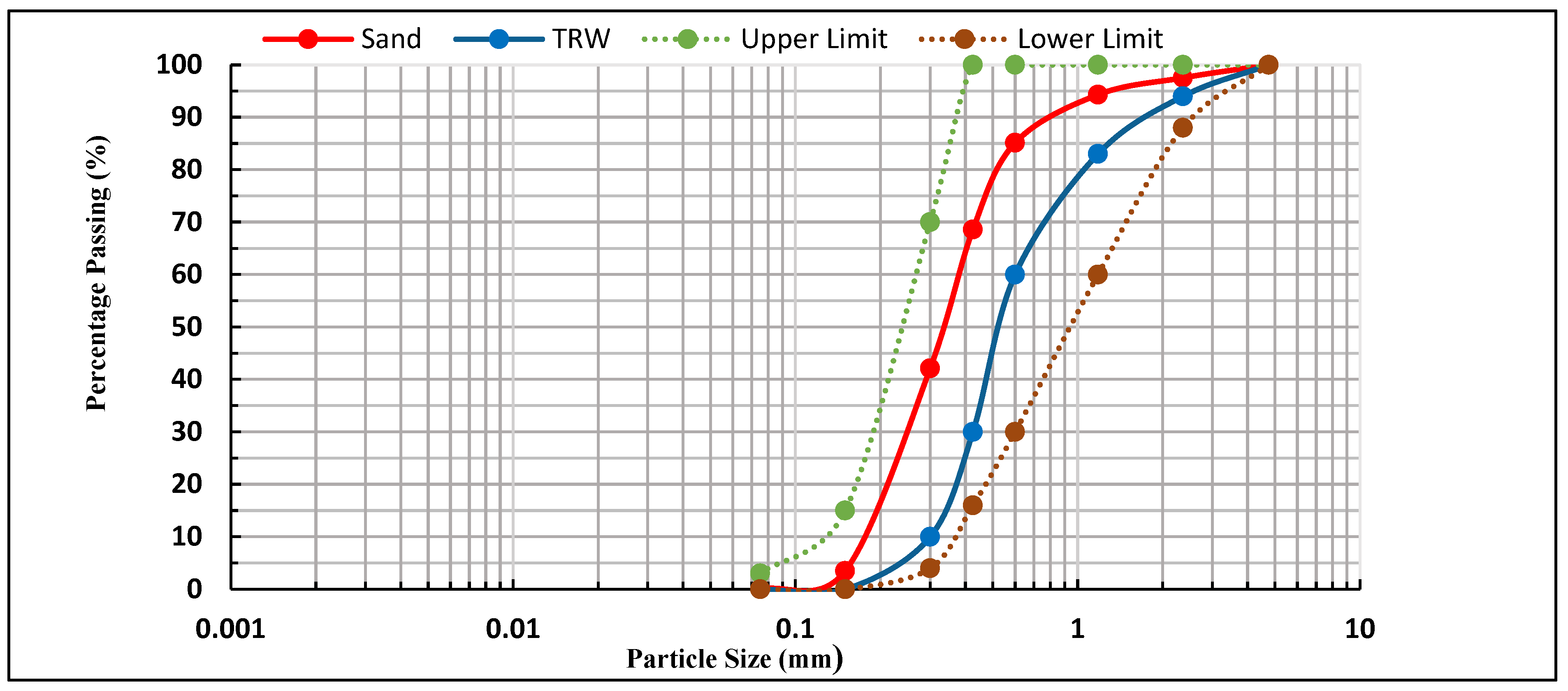
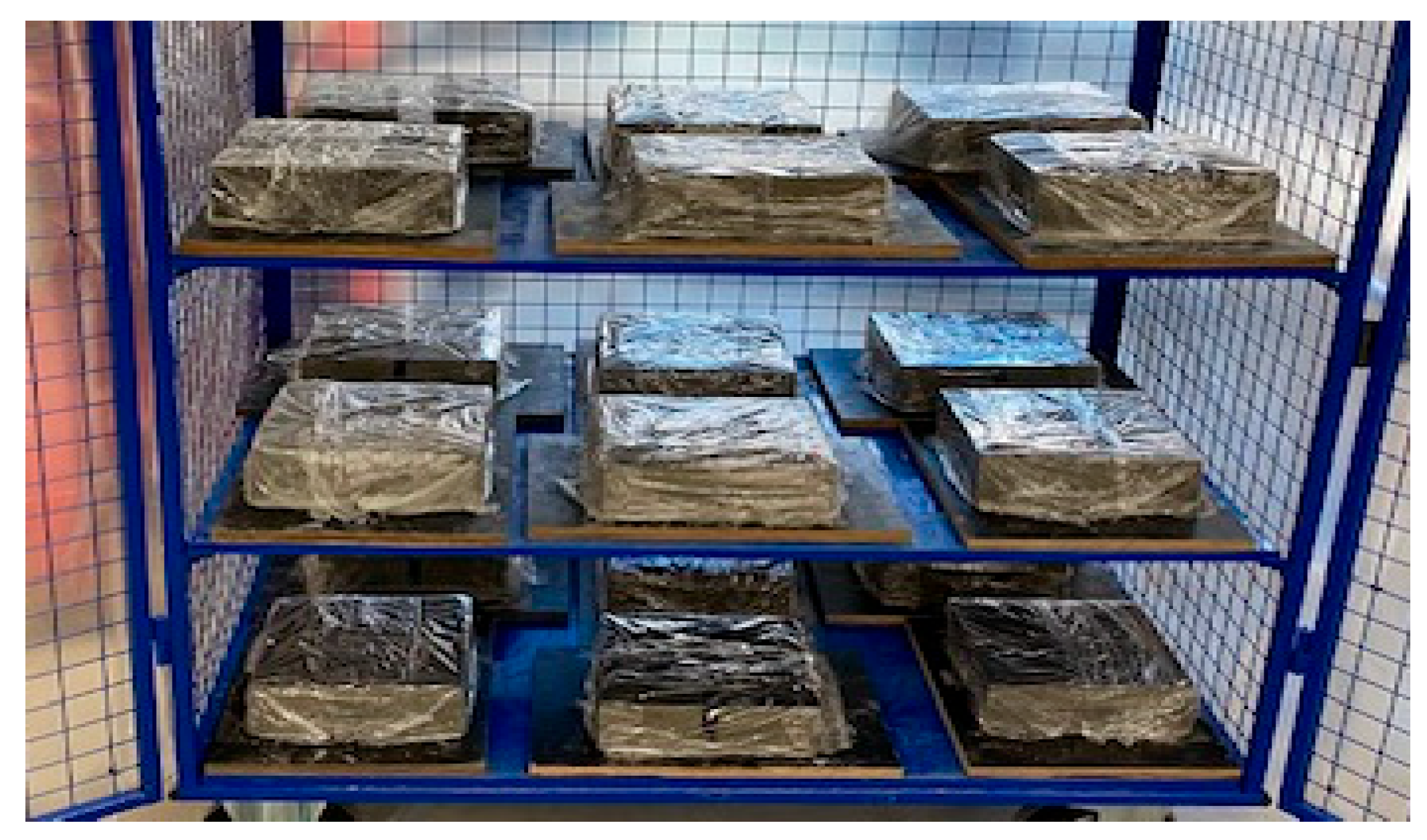

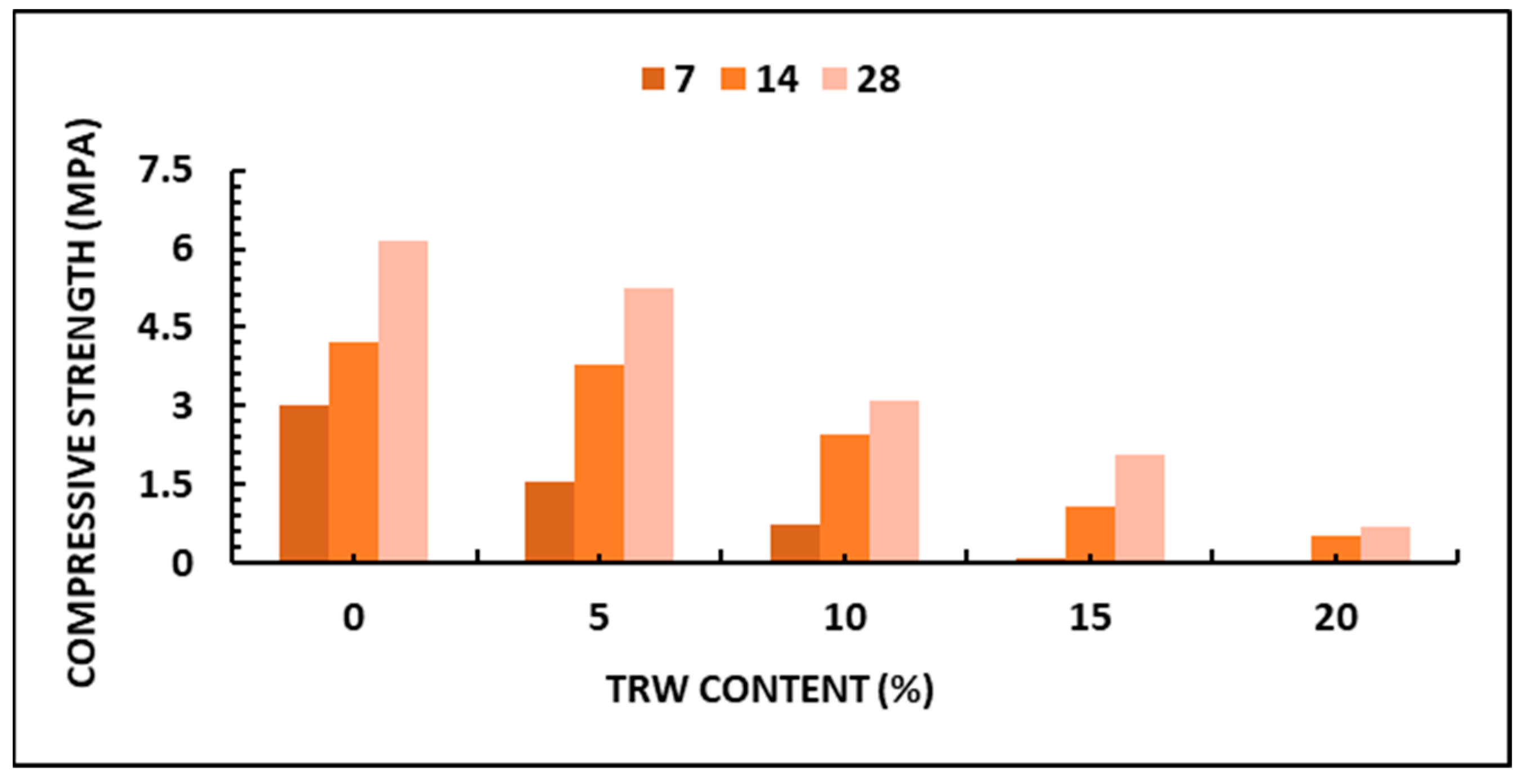
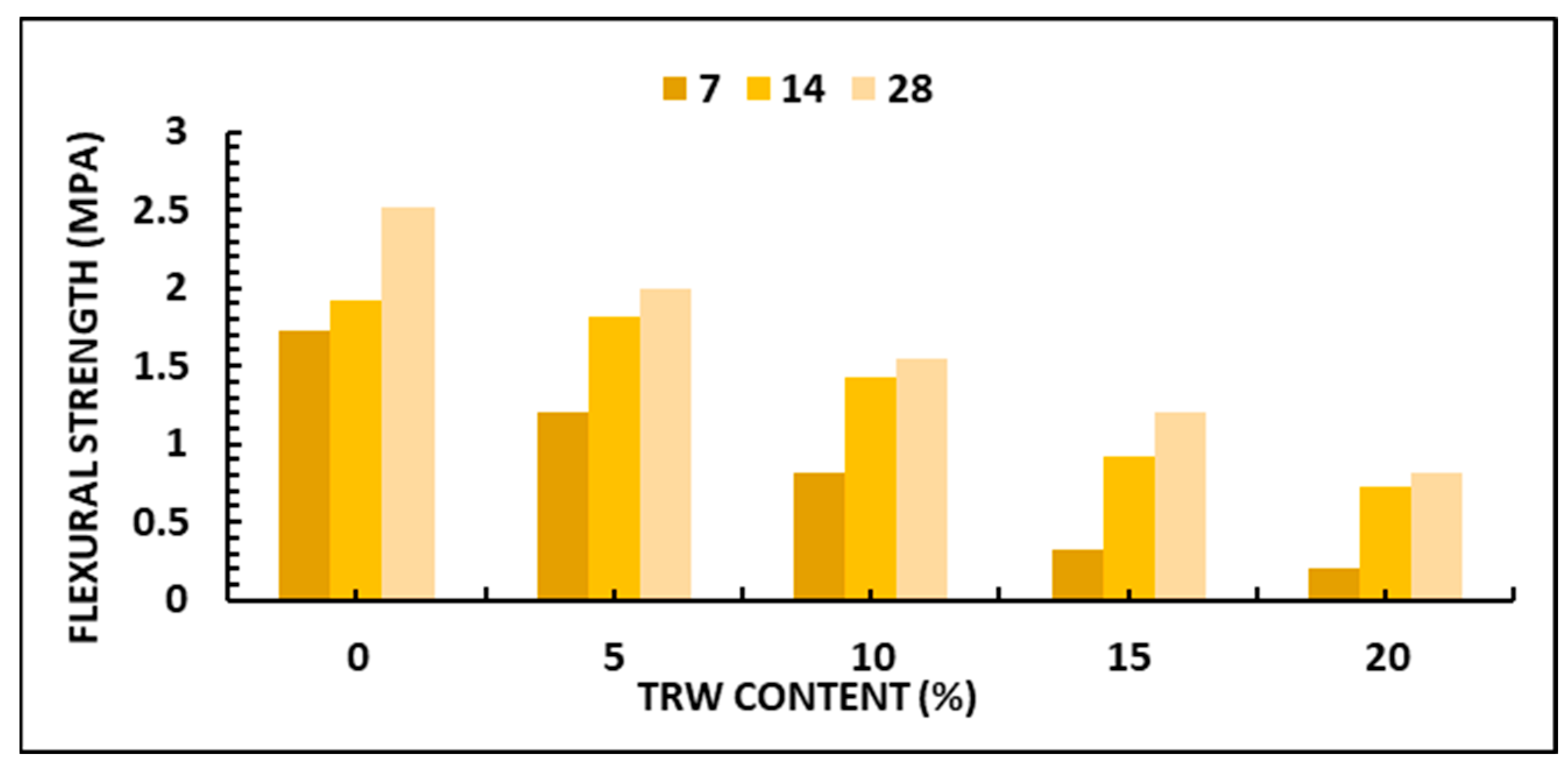
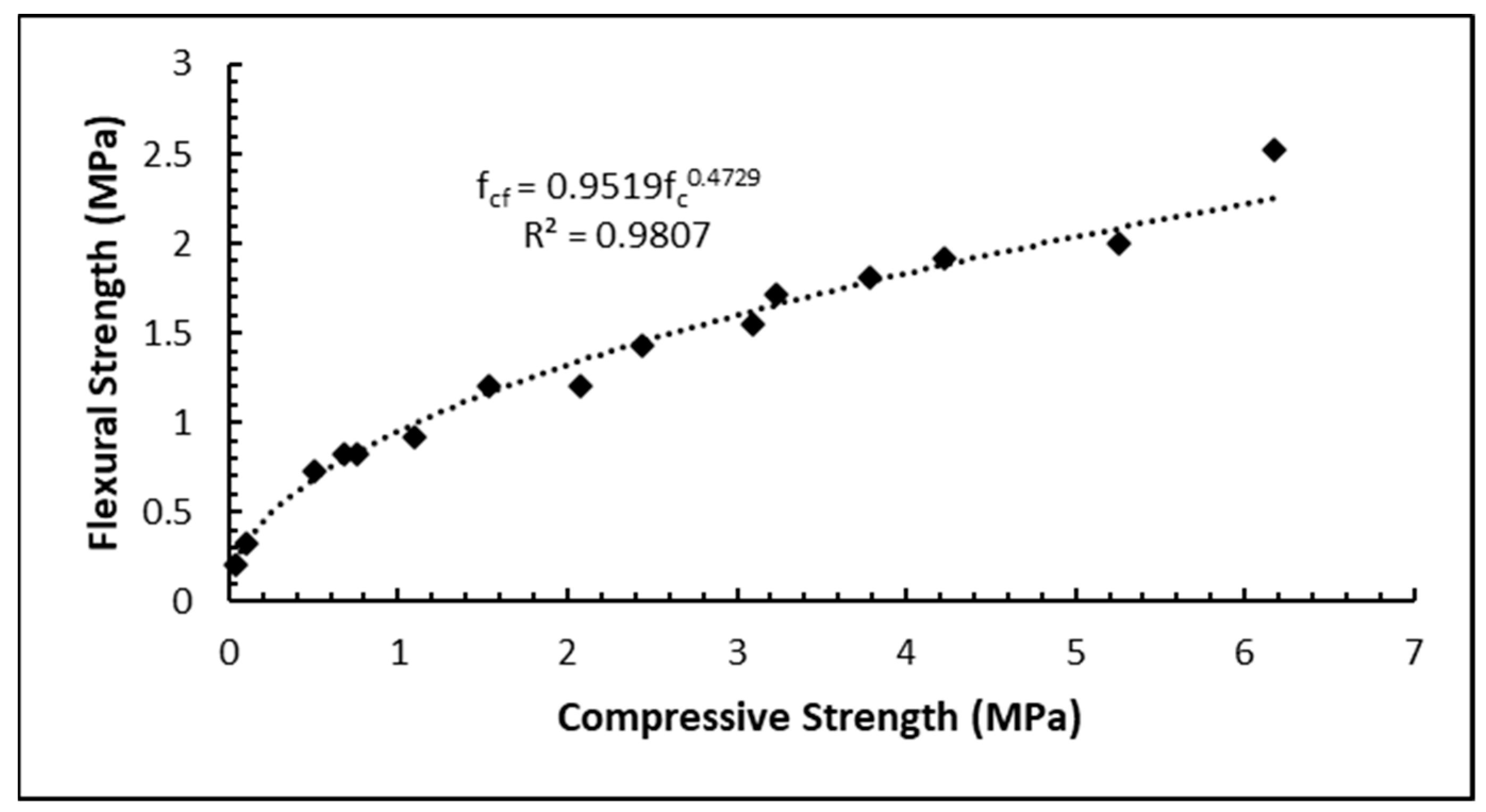


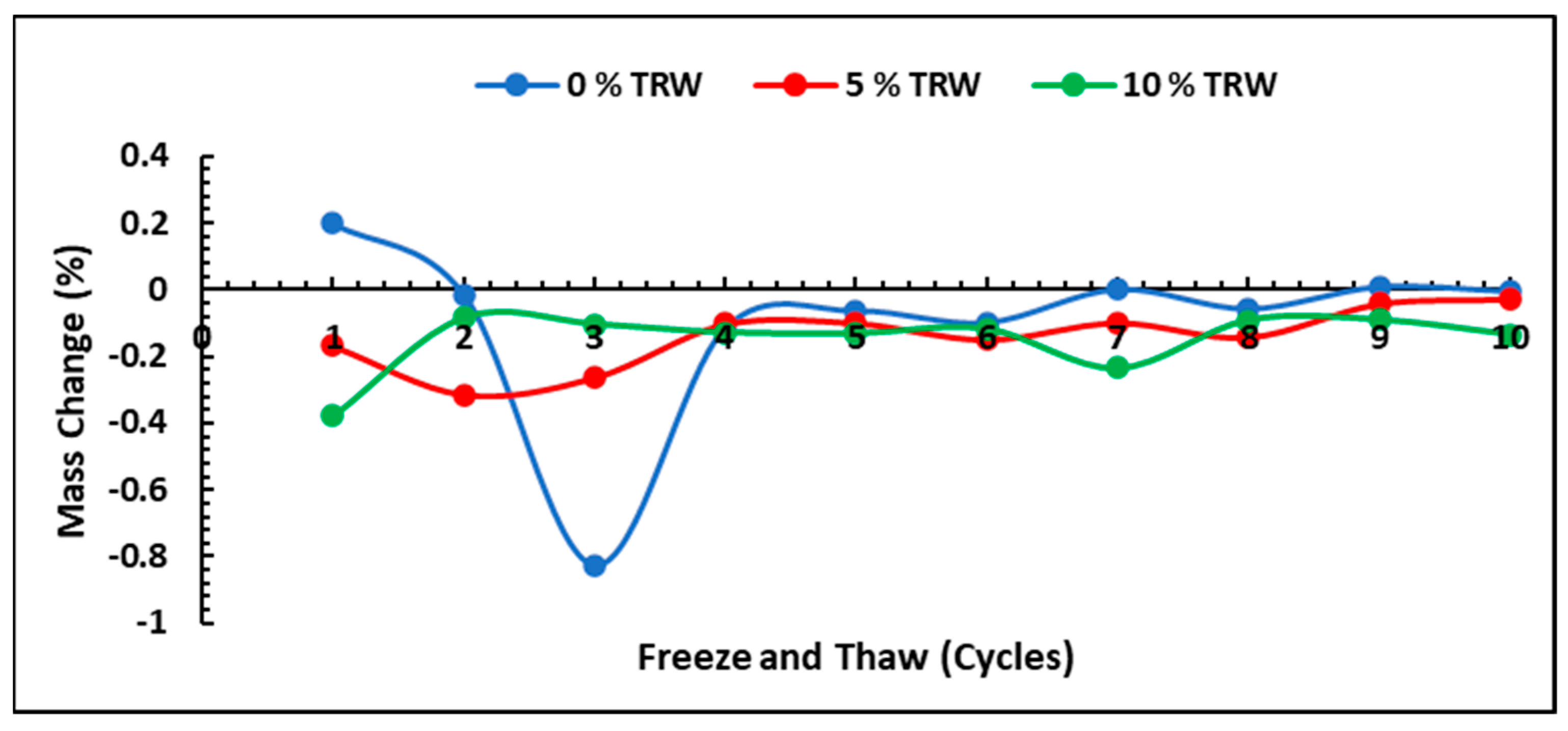
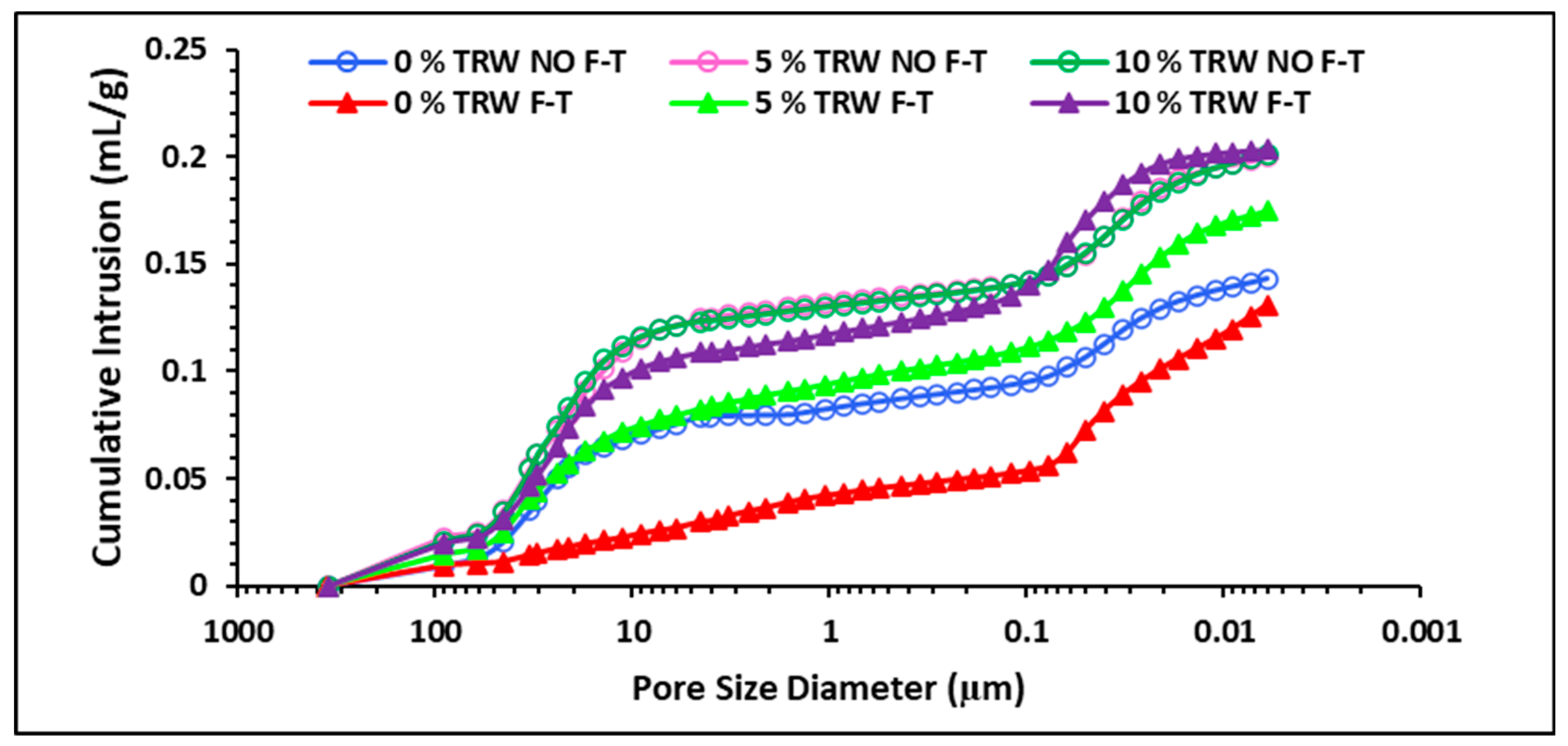

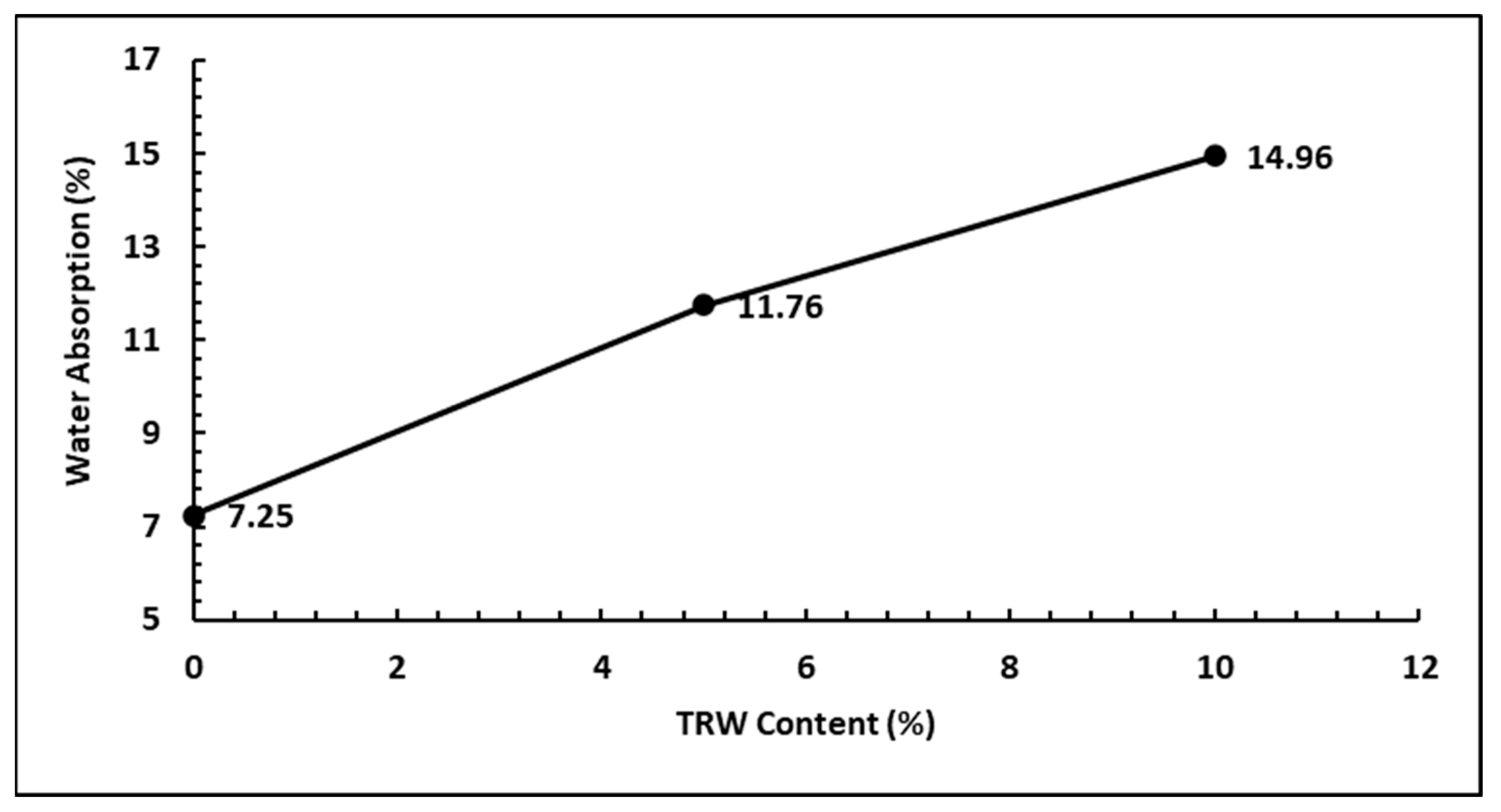
| Sample | Chemical Composition (%) | |||||||
|---|---|---|---|---|---|---|---|---|
| CaO | SiO2 | Al2O3 | Fe2O3 | MgO | K2O | Na2O | SO3 | |
| LKD | 63.42 | 20.04 | 4.90, | 3.49 | 1.11 | 0.35 | 0.43 | 2.35 |
| GGBFS | 42.1 | 33.1 | 13.2 | 0.3 | 6.5 | - | 0.5 | 2.0 |
| LKD-GGBFS/Sand Ratio | LKD-GGBFS Blend Ratio | 28-Day CS (MPa) |
|---|---|---|
| 1:3 | 90–10 | 1.67 |
| 1:3 | 80–20 | 3.69 |
| 1:3 | 70–30 | 6.17 |
| 1:3 | 60–40 | 10.49 |
| 1:3 | 50–50 | 8.71 |
| 1:3 | 40–60 | 11.94 |
| 1:3 | 30–70 | 12.04 |
| TRW (%) | Hydration (Days) | Compressive Strength (MPa) | Flexural Strength (MPa) |
|---|---|---|---|
| 0 | 7 | 3.23 | 1.72 |
| 0 | 14 | 4.22 | 1.92 |
| 0 | 28 | 6.17 | 2.52 |
| 5 | 7 | 1.54 | 1.2 |
| 5 | 14 | 3.79 | 1.81 |
| 5 | 28 | 5.25 | 2 |
| 10 | 7 | 0.76 | 0.82 |
| 10 | 14 | 2.44 | 1.43 |
| 10 | 28 | 3.09 | 1.55 |
| 15 | 7 | 0.1 | 0.32 |
| 15 | 14 | 1.1 | 0.92 |
| 15 | 28 | 2.08 | 1.20 |
| 20 | 7 | 0.04 | 0.21 |
| 20 | 14 | 0.5 | 0.73 |
| 20 | 28 | 0.68 | 0.82 |
| Mathematical Relationship | Mathematical Model | Correlation Coefficient (R2) |
|---|---|---|
| Exponential | = 0.5244e0.3073fc | 0.8237 |
| Linear | = 0.3326fc + 0.5022 | 0.9509 |
| Power | = 0.9519fc0.4729 | 0.9807 |
| Logarithmic | = 0.4157ln(fc) + 1.1719 | 0.8531 |
Disclaimer/Publisher’s Note: The statements, opinions and data contained in all publications are solely those of the individual author(s) and contributor(s) and not of MDPI and/or the editor(s). MDPI and/or the editor(s) disclaim responsibility for any injury to people or property resulting from any ideas, methods, instructions or products referred to in the content. |
© 2024 by the authors. Licensee MDPI, Basel, Switzerland. This article is an open access article distributed under the terms and conditions of the Creative Commons Attribution (CC BY) license (https://creativecommons.org/licenses/by/4.0/).
Share and Cite
Oke, J.A.; Abuel-Naga, H. Durability Assessment of Eco-Friendly Bricks Containing Lime Kiln Dust and Tire Rubber Waste Using Mercury Intrusion Porosimetry. Appl. Sci. 2024, 14, 5131. https://doi.org/10.3390/app14125131
Oke JA, Abuel-Naga H. Durability Assessment of Eco-Friendly Bricks Containing Lime Kiln Dust and Tire Rubber Waste Using Mercury Intrusion Porosimetry. Applied Sciences. 2024; 14(12):5131. https://doi.org/10.3390/app14125131
Chicago/Turabian StyleOke, Joy Ayankop, and Hossam Abuel-Naga. 2024. "Durability Assessment of Eco-Friendly Bricks Containing Lime Kiln Dust and Tire Rubber Waste Using Mercury Intrusion Porosimetry" Applied Sciences 14, no. 12: 5131. https://doi.org/10.3390/app14125131
APA StyleOke, J. A., & Abuel-Naga, H. (2024). Durability Assessment of Eco-Friendly Bricks Containing Lime Kiln Dust and Tire Rubber Waste Using Mercury Intrusion Porosimetry. Applied Sciences, 14(12), 5131. https://doi.org/10.3390/app14125131






